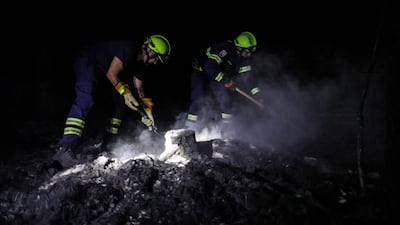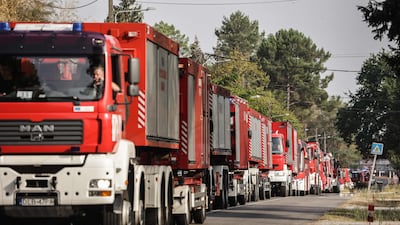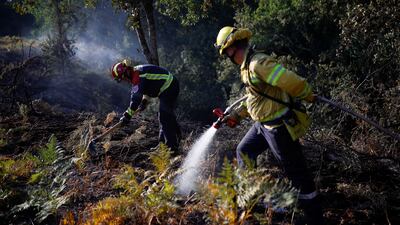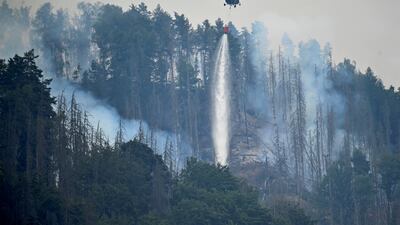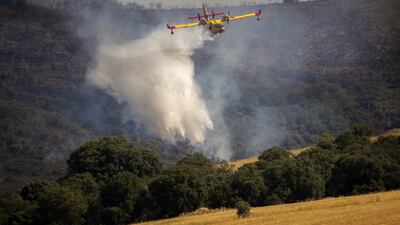So many people died from disease, war and enslavement during the European conquest of the Americas that Amazonian forests grew back, reducing atmospheric carbon dioxide and perhaps contributing to the “Little Ice Age” of the 17th century.
Today, forests provide a more positive hope of limiting global heating. But the current approach is failing.
The idea of biological-based carbon credits is that an emitter of carbon dioxide – say, an airline – can fund a project that protects trees, plants new ones, or conserves other carbon-containing ecosystems such as peat bogs – wetlands with partially decayed vegetation – or mangroves. These projects are accredited under approved methodologies by major registries such as Verra and Gold Standard.
In the ideal case, such offsets balance out carbon dioxide emissions, protect a fragile ecosystem, bring some benefits to local communities, and have other positive impacts such as anchoring soils and limiting flooding.
But in recent months, it has become abundantly clear that bio-based offsets have significant problems that render them useless or are even counterproductive and environmentally harmful.
One of the most dramatic developments came in Zimbabwe last month. Kariba, a forest protection project covering an area almost twice that of the emirate of Dubai, saw its main partner South Pole withdraw. The project sold 23 million tonnes worth of credits, for almost $100 million, but its climate benefits appear to have been overstated by a factor of five, while money went to the developers rather than the local communities tasked with actually reducing deforestation.
This should perhaps have been obvious from the cheapness of such offsets: $1 to $2 per tonne of carbon dioxide for “low-quality” credits and up to $10 to $20 for high-quality ones. If it were that cheap to stop global warming, we would have done it already. For comparison, carbon prices in the world’s leading trading system, that of the EU, currently range around $90 per tonne and are likely to go much higher.
Companies may skimp on reducing their emissions, instead buying credits to claim to be “carbon neutral”, or falsely convince consumers that unsustainable activities can be cheaply offset.
Some problems are practical. Proper measurement and verification is tricky and expensive, especially if done well, although new satellite methods offer improvements.
Carbon runs between trunks and leaves, roots, dead wood, charcoal and carbon in soils, and when disturbed, some may be released.
Trees don’t soak up much carbon dioxide immediately when planted, but only as they grow to maturity over several decades. That is problematic when we are facing rapid warming today. Once mature, trees absorb little extra carbon, yet they have to be kept alive or replaced with new growth in perpetuity.
A hotter planet sparks stronger wildfires. California, Canada, Australia and the Mediterranean have been hit by vast conflagrations in recent years. This can wipe out millions of tonnes of offsets in hours, eliminating the reserve that issuers hold back. Drought and pests can also damage forests.
Preserving existing forests is conceptually hard to assess. Were trees ever really in danger of being destroyed? Project proponents have the temptation to exaggerate. Some studies suggest that as much as 90 per cent of rainforest protection credits are worthless.
Reforestation might seem more tangible. But the cheapest approach is monoculture: setting up vast plantations of identical fast-growing species. These, though, are disastrous for biodiversity, probably offering fewer habitats for wildlife than the grasslands they replace. This applies particularly to trees planted for biofuels, such as oil palms. However, only planting seeds can be ineffective when trees are not tended and are at risk of dying from drought.
Preserving or reforesting specific locations without addressing the root causes of deforestation – rising demand for meat, animal feed and biofuels – is likely to displace farming and ranching activity elsewhere. Locals may be excluded from areas they had relied on for food and firewood and see little of the payments made.
Yet, it is good to pay to protect vulnerable forests and other ecosystems. It is good to keep carbon out of the atmosphere or draw it into plants and soils. It is good to bring another source of income to impoverished rural communities. And it is essential to find affordable ways to counteract residual, unavoidable emissions. So how do we make the offset system work?
Accounting, methodological fixes, more scrutiny and reviews are only tinkering around the edges.
Financial reporting and dealing with real dollars recorded in bank accounts is prone enough to fraud and scandals – think how long Enron was able to fool investors and regulators.
Much harder is measuring levels of soil and trees and then assessing the counterfactual of how much carbon would have been emitted in the absence of offset projects.
A real fix would have three key components. First, bio-offsets are a temporary form of carbon storage. They should only be issued in alignment with the actual growth of a forest and its carbon storage.
The credits should endure for a defined period, like a bond, that has to be repaid – either with a new issuance or with a permanent form of carbon removal such as storing carbon dioxide underground or turning it into solid minerals. If a project is logged or destroyed by pests or wildfires, credits should have to be replaced immediately.
Second, the amount of the offset should be discounted to represent the displacement of some deforestation to another location.
Third, the social and biodiversity effects should be separated from carbon storage and valued individually. Companies that contribute to deforestation – such as logging, agribusinesses and biofuels makers – could offset that part with contributions from governments.
At Cop28, which starts at the end of this month in Dubai, topics of debate include carbon offsets and trading, compensating lower-income countries for losses and damage due to climate change, bringing finance to developing countries, and the role of carbon capture and storage.
Proper use of bio-based offsets has the potential to tie all of these challenges together. But cosmetic fixes are not enough. The system can only be saved by a root-and-branch rethink.
Robin M. Mills is chief executive of Qamar Energy, and author of The Myth of the Oil Crisis
THE TWIN BIO
Their favourite city: Dubai
Their favourite food: Khaleeji
Their favourite past-time : walking on the beach
Their favorite quote: ‘we rise by lifting others’ by Robert Ingersoll
MORE ON INTERNATIONAL JUSTICE
Results
5pm: Maiden (PA) Dh80,000 (Turf) 1,000mm, Winners: Mumayaza, Fabrice Veron (jockey), Eric Lemartinel (trainer)
5.30pm: Wathba Stallions Cup Handicap (PA) Dh70,000 (T) 2,200m, Winners: Sharkh, Pat Cosgrave, Helal Al Alawi
6pm: The President’s Cup Prep - Conditions (PA) Dh100,000 (T) 2,200m, Winner: Somoud, Richard Mullen, Jean de Roualle
6.30pm: Handicap (PA) Dh90,000 (T) 1,600m, Winner: Harrab, Ryan Curatolo, Jean de Roualle
7pm: Abu Dhabi Equestrian Gold Cup - Prestige (PA) Dh125,000 (T) 1,600m, Winner: Hameem, Adrie de Vries, Abdallah Al Hammadi
7.30pm: Al Ruwais – Group 3 (PA) Dh300,000 (T) 1,200m, Winner: AF Alwajel, Tadhg O’Shea, Ernst Oertel
8pm: Maiden (TB) Dh80,000 (T) 1,400m, Winner: Nibras Passion, Bernardo Pinheiro, Ismail Mohammed
Company%C2%A0profile
%3Cp%3E%3Cstrong%3ECompany%20name%3A%20%3C%2Fstrong%3Eamana%3Cbr%3E%3Cstrong%3EStarted%3A%20%3C%2Fstrong%3E2010%3Cbr%3E%3Cstrong%3EFounders%3A%3C%2Fstrong%3E%20Karim%20Farra%20and%20Ziad%20Aboujeb%3Cbr%3E%3Cstrong%3EBased%3A%20%3C%2Fstrong%3EUAE%3Cbr%3E%3Cstrong%3ERegulator%3A%20%3C%2Fstrong%3EDFSA%3Cbr%3E%3Cstrong%3ESector%3A%20%3C%2Fstrong%3EFinancial%20services%3Cbr%3E%3Cstrong%3ECurrent%20number%20of%20staff%3A%20%3C%2Fstrong%3E85%3Cbr%3E%3Cstrong%3EInvestment%20stage%3A%20%3C%2Fstrong%3ESelf-funded%3Cbr%3E%3C%2Fp%3E%0A
Avengers: Endgame
Directors: Anthony Russo, Joe Russo
Starring: Robert Downey Jr, Chris Evans, Scarlett Johansson, Chris Hemsworth, Josh Brolin
4/5 stars
Specs
Engine: 51.5kW electric motor
Range: 400km
Power: 134bhp
Torque: 175Nm
Price: From Dh98,800
Available: Now
Cricket World Cup League 2
UAE squad
Rahul Chopra (captain), Aayan Afzal Khan, Ali Naseer, Aryansh Sharma, Basil Hameed, Dhruv Parashar, Junaid Siddique, Muhammad Farooq, Muhammad Jawadullah, Muhammad Waseem, Omid Rahman, Rahul Bhatia, Tanish Suri, Vishnu Sukumaran, Vriitya Aravind
Fixtures
Friday, November 1 – Oman v UAE
Sunday, November 3 – UAE v Netherlands
Thursday, November 7 – UAE v Oman
Saturday, November 9 – Netherlands v UAE
The%20specs%3A%202024%20Mercedes%20E200
%3Cp%3E%3Cstrong%3EEngine%3A%20%3C%2Fstrong%3E2.0-litre%20four-cyl%20turbo%20%2B%20mild%20hybrid%0D%3Cbr%3E%3Cstrong%3EPower%3A%20%3C%2Fstrong%3E204hp%20at%205%2C800rpm%20%2B23hp%20hybrid%20boost%0D%3Cbr%3E%3Cstrong%3ETorque%3A%20%3C%2Fstrong%3E320Nm%20at%201%2C800rpm%20%2B205Nm%20hybrid%20boost%0D%3Cbr%3E%3Cstrong%3ETransmission%3A%20%3C%2Fstrong%3E9-speed%20auto%0D%3Cbr%3E%3Cstrong%3EFuel%20consumption%3A%20%3C%2Fstrong%3E7.3L%2F100km%0D%3Cbr%3E%3Cstrong%3EOn%20sale%3A%20%3C%2Fstrong%3ENovember%2FDecember%0D%3Cbr%3E%3Cstrong%3EPrice%3A%20%3C%2Fstrong%3EFrom%20Dh205%2C000%20(estimate)%3C%2Fp%3E%0A
The specs
Engine: 3.0-litre six-cylinder turbo
Power: 398hp from 5,250rpm
Torque: 580Nm at 1,900-4,800rpm
Transmission: Eight-speed auto
Fuel economy, combined: 6.5L/100km
On sale: December
Price: From Dh330,000 (estimate)
UAE currency: the story behind the money in your pockets
Tamkeen's offering
- Option 1: 70% in year 1, 50% in year 2, 30% in year 3
- Option 2: 50% across three years
- Option 3: 30% across five years
About Housecall
Date started: July 2020
Founders: Omar and Humaid Alzaabi
Based: Abu Dhabi
Sector: HealthTech
# of staff: 10
Funding to date: Self-funded
ARGYLLE
%3Cp%3EDirector%3A%20Matthew%20Vaughn%3C%2Fp%3E%0A%3Cp%3EStarring%3A%20Bryce%20Dallas%20Howard%2C%20Sam%20Rockwell%2C%20John%20Cena%3C%2Fp%3E%0A%3Cp%3ERating%3A%203%2F5%3C%2Fp%3E%0A
Teachers' pay - what you need to know
Pay varies significantly depending on the school, its rating and the curriculum. Here's a rough guide as of January 2021:
- top end schools tend to pay Dh16,000-17,000 a month - plus a monthly housing allowance of up to Dh6,000. These tend to be British curriculum schools rated 'outstanding' or 'very good', followed by American schools
- average salary across curriculums and skill levels is about Dh10,000, recruiters say
- it is becoming more common for schools to provide accommodation, sometimes in an apartment block with other teachers, rather than hand teachers a cash housing allowance
- some strong performing schools have cut back on salaries since the pandemic began, sometimes offering Dh16,000 including the housing allowance, which reflects the slump in rental costs, and sheer demand for jobs
- maths and science teachers are most in demand and some schools will pay up to Dh3,000 more than other teachers in recognition of their technical skills
- at the other end of the market, teachers in some Indian schools, where fees are lower and competition among applicants is intense, can be paid as low as Dh3,000 per month
- in Indian schools, it has also become common for teachers to share residential accommodation, living in a block with colleagues
Company Profile
Name: Thndr
Started: 2019
Co-founders: Ahmad Hammouda and Seif Amr
Sector: FinTech
Headquarters: Egypt
UAE base: Hub71, Abu Dhabi
Current number of staff: More than 150
Funds raised: $22 million
The%20specs
%3Cp%3E%3Cstrong%3EEngine%3A%3C%2Fstrong%3E%201.5-litre%204-cylinder%3Cbr%3E%3Cstrong%3ETransmission%3A%20%3C%2Fstrong%3ECVT%3Cbr%3E%3Cstrong%3EPower%3A%20%3C%2Fstrong%3E119bhp%3Cbr%3E%3Cstrong%3ETorque%3A%20%3C%2Fstrong%3E145Nm%3Cbr%3E%3Cstrong%3EPrice%3A%20%3C%2Fstrong%3EDh%2C89%2C900%20(%2424%2C230)%3Cbr%3E%3Cstrong%3EOn%20sale%3A%20%3C%2Fstrong%3Enow%3C%2Fp%3E%0A
Read more about the coronavirus
Brief scores:
England: 290 & 346
Sri Lanka: 336 & 243
THE SIXTH SENSE
Starring: Bruce Willis, Toni Collette, Hayley Joel Osment
Director: M. Night Shyamalan
Rating: 5/5
Company%20profile
%3Cp%3E%3Cstrong%3EName%3A%3C%2Fstrong%3E%20WallyGPT%3Cbr%3E%3Cstrong%3EStarted%3A%20%3C%2Fstrong%3E2014%3Cbr%3E%3Cstrong%3EFounders%3A%20%3C%2Fstrong%3ESaeid%20and%20Sami%20Hejazi%3Cbr%3E%3Cstrong%3EBased%3A%3C%2Fstrong%3E%20Dubai%3Cbr%3E%3Cstrong%3ESector%3A%20%3C%2Fstrong%3EFinTech%3Cbr%3E%3Cstrong%3EInvestment%20raised%3A%20%3C%2Fstrong%3E%247.1%20million%3Cbr%3E%3Cstrong%3ENumber%20of%20staff%3A%3C%2Fstrong%3E%2020%3Cbr%3E%3Cstrong%3EInvestment%20stage%3A%20%3C%2Fstrong%3EPre-seed%20round%3C%2Fp%3E%0A
Zayed Sustainability Prize
MATCH INFO
Uefa Champions League final:
Who: Real Madrid v Liverpool
Where: NSC Olimpiyskiy Stadium, Kiev, Ukraine
When: Saturday, May 26, 10.45pm (UAE)
TV: Match on BeIN Sports
UPI facts
More than 2.2 million Indian tourists arrived in UAE in 2023
More than 3.5 million Indians reside in UAE
Indian tourists can make purchases in UAE using rupee accounts in India through QR-code-based UPI real-time payment systems
Indian residents in UAE can use their non-resident NRO and NRE accounts held in Indian banks linked to a UAE mobile number for UPI transactions
Small Victories: The True Story of Faith No More by Adrian Harte
Jawbone Press
GIANT REVIEW
Starring: Amir El-Masry, Pierce Brosnan
Director: Athale
Rating: 4/5
THE%20SPECS
%3Cp%3EBattery%3A%2060kW%20lithium-ion%20phosphate%3Cbr%3EPower%3A%20Up%20to%20201bhp%3Cbr%3E0%20to%20100kph%3A%207.3%20seconds%3Cbr%3ERange%3A%20418km%3Cbr%3EPrice%3A%20From%20Dh149%2C900%3Cbr%3EAvailable%3A%20Now%3C%2Fp%3E%0A




